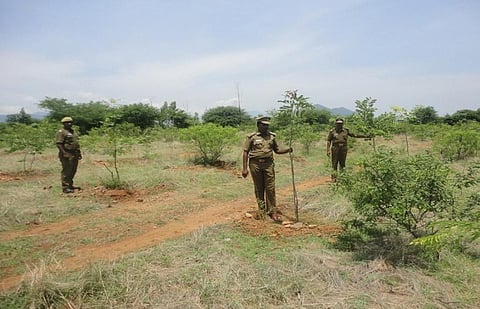How Auroville can teach us all a thing or two about offsetting carbon
Planting activities undertaken under CAMPA monitored during 2015-16 in Salem Division of Tamil Nadu. Photo: V Sundararaju
The latest developments in the field of climate science teach us that carbon sequestration is one of the best ways to mitigate global warming.
But unless the tree cover outside forests is increased, it may not be possible to stop the march of climate change powered by the use of fossil fuels in transport.
The Auroville Forest Group, a non-profit in Puducherry, has introduced a new method of increasing tree cover that can mitigate climate change effectively in the future.
Auroville, an international town in Puducherry, has planted about three million trees from 1968 onwards. The sincere attempt has created a green belt of 1,380 acres around Auroville.
The non-profit has removed invasive alien species, planted native tree species and improved the area through various soil and moisture conservation measures like building check dams and percolation ponds. Above all, protection from wood cutters and grazing has provided very good results.
Read DTE’s coverage on CAMPA
The non-profit has found that 30 tropical dry evergreen forest trees indigenous to the town can sequester one million tonnes of carbon during their lifetime.
The group uses a carbon converter, a greenhouse gas (GHG) emission calculator, a tool using global conversion factor from the GHG Protocol for Corporate Accounting, to convert transport details into total emissions.
Transport emissions due to flights, cars, buses and trains can be calculated by using the method. The emissions arrived at are calculated in kilograms of carbon dioxide equivalent.
For example, if one travels from Chennai to Delhi by flight, the distance travelled is 1,763 kilometres, with a total emission of 213 kg of CO2. In that case, eight trees are to be planted for carbon offsetting, at a cost of Rs 944.
If one travels by car from Chennai to Bangalore, the distance covered is 290 kilometres, with a total emission of 35 kg of Co2. So, one has to plant one tree, with a cost of Rs 118.
Thus, the impact of transport on the environment can be calculated and the same can be compensated by planting the required number of trees.
The Auroville Forest Group takes care of the plants planted on behalf of citizens in Auroville with watering, soil work and pest control measures.
Lessons learnt
The Government of India can enact a special act — Climate Change Mitigation (through tree planting) Act — emulating the same methodology as the one followed in Auroville.
Due provision for carbon offsetting can be provided under the Act. A green tax may be calculated by considering the carbon emissions from cars, buses, trains and flights and the cost of planting the required number of trees and subsequent maintenance.
The tax can be collected from the concerned transport operators through the concerned departments which have control over them.
The same amount can be allotted to the city corporation or the forest department concerned for carrying out planting activities. These will be subject to monitoring and evaluation by outside agencies appointed by the Union environment ministry.
Currently, compensatory afforestation programmes are being carried out by the state forest departments from the funds allotted by the Centre.
Whenever any forest area is diverted for any non-forestry programme, twice the extent of land and the charges for afforestation and soil and moisture conservation measures are collected from the concerned departments.
The same fund is utilised under the Compensatory Afforestation Fund Management and Planning Authority (CAMPA) and is monitored and evaluated subsequently.
Similarly, the fund collected under the Climate Change Mitigation (through planting of trees) Act from the transport authorities can be allotted to the concerned state governments by the Union environment ministry. The planting activities can be monitored and evaluated subsequently by any outside agency for effective management of the programme.
The idea suggested can be discussed with the concerned authorities for earnest introduction of the Act and the same can be effectively implemented for the mitigation of climate change.
V Sundararaju is President, the Society for Conservation of Nature, Trichy, Tamil Nadu and consultant with the Society for Social Forest Research & Development, Tamil Nadu
Views expressed are the author’s own and don’t necessarily reflect those of Down To Earth


